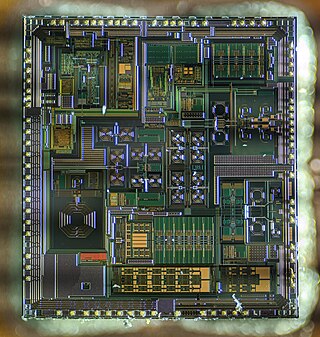Related Research Articles

General Packet Radio Service (GPRS), also called 2.5G, is a mobile data standard on the 2G cellular communication network's global system for mobile communications (GSM). Networks and mobile devices with GPRS started to roll out around the year 2001. At the time of introduction it offered for the first time seamless mobile data transmission using packet data for an "always-on" connection, providing improved Internet access for web, email, WAP services, and Multimedia Messaging Service (MMS).

A wireless network is a computer network that uses wireless data connections between network nodes. Wireless networking allows homes, telecommunications networks and business installations to avoid the costly process of introducing cables into a building, or as a connection between various equipment locations. Admin telecommunications networks are generally implemented and administered using radio communication. This implementation takes place at the physical level (layer) of the OSI model network structure.

A SIMcard is an integrated circuit (IC) intended to securely store an international mobile subscriber identity (IMSI) number and its related key, which are used to identify and authenticate subscribers on mobile telephone devices. SIMs are also able to store address book contacts information, and may be protected using a PIN code to prevent unauthorized use.
IS-54 and IS-136 are second-generation (2G) mobile phone systems, known as Digital AMPS (D-AMPS), and most often referred to as TDMA, are a further development of the North American 1G mobile system Advanced Mobile Phone System (AMPS). It was once prevalent throughout the Americas, particularly in the United States and Canada since the first commercial network was deployed in 1993. D-AMPS is considered end-of-life, and existing networks have mostly been replaced by GSM/GPRS or CDMA2000 technologies.

PMC-Sierra was a global fabless semiconductor company with offices worldwide that developed and sold semiconductor devices into the storage, communications, optical networking, printing, and embedded computing marketplaces.

Telematics is an interdisciplinary field encompassing telecommunications, vehicular technologies, electrical engineering, and computer science. Telematics can involve any of the following:
OMA SpecWorks, previously the Open Mobile Alliance (OMA), is a standards organization which develops open, international technical standards for the mobile phone industry. It is a nonprofit Non-governmental organization (NGO), not a formal government-sponsored standards organization as is the International Telecommunication Union (ITU): a forum for industry stakeholders to agree on common specifications for products and services.

A mobile phone feature is a capability, service, or application that a mobile phone offers to its users. Mobile phones are often referred to as feature phones, and offer basic telephony. Handsets with more advanced computing ability through the use of native code try to differentiate their own products by implementing additional functions to make them more attractive to consumers. This has led to great innovation in mobile phone development over the past 20 years.

Telit Cinterion is an Internet of Things (IoT) Enabler company headquartered in Irvine, California, United States. It is a privately held company with key operations in the US, Brazil, Italy, Israel, and Korea.
Machine to machine (M2M) is direct communication between devices using any communications channel, including wired and wireless. Machine to machine communication can include industrial instrumentation, enabling a sensor or meter to communicate the information it records to application software that can use it. Such communication was originally accomplished by having a remote network of machines relay information back to a central hub for analysis, which would then be rerouted into a system like a personal computer.

Wi-Fi calling, also called VoWiFi, refers to mobile phone voice calls and data that are made over IP networks using Wi-Fi, instead of the cell towers provided by cellular networks. Using this feature, compatible handsets are able to route regular cellular calls through a wireless LAN (Wi-Fi) network with broadband Internet, while seamlessly change connections between the two where necessary. This feature makes use of the Generic Access Network (GAN) protocol, also known as Unlicensed Mobile Access (UMA).

Sierra Wireless is a Canadian multinational wireless communications equipment designer, manufacturer and services provider headquartered in Richmond, British Columbia, Canada. It also maintains offices and operations in the United States, Korea, Japan, Taiwan, India, France, Australia and New Zealand.
A connected car is a car that can communicate bidirectionally with other systems outside of the car. This connectivity can be used to provide services to passengers or to support or enhance self-driving functionality. For safety-critical applications, it is anticipated that cars will also be connected using dedicated short-range communications (DSRC) or cellular radios, operating in the FCC-granted 5.9 GHz band with very low latency.
ERM Electronic Systems ltd., also known as ERM Advanced Telematics, is an Israeli electronic company specializing in the design, development, and manufacture of vehicle security and GPS tracking devices for the telematics and fleet management industry. ERM Advanced Telematics operates globally, providing telematics devices for Stolen Vehicle Recovery (SVR) and Fleet Management Solutions (FMS).

u-blox is a Swiss company that creates wireless semiconductors and modules for consumer, automotive and industrial markets. They operate as a fabless IC and design house. The company is listed at the Swiss Stock Exchange (SIX:UBXN) and has offices in the US, Singapore, China, Taiwan, Korea, Japan, India, Pakistan, Australia, Ireland, the UK, Belgium, Germany, Sweden, Finland, Italy and Greece.

Airbiquity Inc. was a business-to-business (B2B) software development and engineering company operating in the automotive telematics industry. Airbiquity's business model was to develop, deploy, and support the ongoing management of connected car programs for automotive industry customers.
Cellemetry Data Services, abbreviated Cellemetry and stylized Cellemetrysm, was a cellular-telephony-based Internet of things network introduced commercially in 1996. Cellemetry was designed to operate over the existing cellular network, allowing it to be rapidly deployed.

A GSM module is a device that allows electronic devices to communicate with each other over the GSM network. GSM is a standard for digital cellular communications, which means that it provides a platform for mobile devices to communicate with each other wirelessly. The GSM module is a specialized device that enables a device to send and receive data over the GSM network.

RF CMOS is a metal–oxide–semiconductor (MOS) integrated circuit (IC) technology that integrates radio-frequency (RF), analog and digital electronics on a mixed-signal CMOS RF circuit chip. It is widely used in modern wireless telecommunications, such as cellular networks, Bluetooth, Wi-Fi, GPS receivers, broadcasting, vehicular communication systems, and the radio transceivers in all modern mobile phones and wireless networking devices. RF CMOS technology was pioneered by Pakistani engineer Asad Ali Abidi at UCLA during the late 1980s to early 1990s, and helped bring about the wireless revolution with the introduction of digital signal processing in wireless communications. The development and design of RF CMOS devices was enabled by van der Ziel's FET RF noise model, which was published in the early 1960s and remained largely forgotten until the 1990s.
References
- ↑ "Wavecom: Company Information". New York Times. Retrieved 2009-02-19.[ dead link ]
- ↑ "Wavecom Introduces Fully Integrated Development Environment for Automotive and Machine-to-Machine Applications". 2009-01-20. Archived from the original on 2013-04-14. Retrieved 2009-02-19.
- 1 2 "Press release "Sierra Wireless Agrees to Acquire Wavecom in Friendly Deal"". www.sec.gov. Retrieved 2024-01-24.
- ↑ Goldstein, Phil (2 December 2008). "Sierra Wireless acquires Wavecom in friendly deal". Fierce Wireless. Retrieved 24 January 2024.